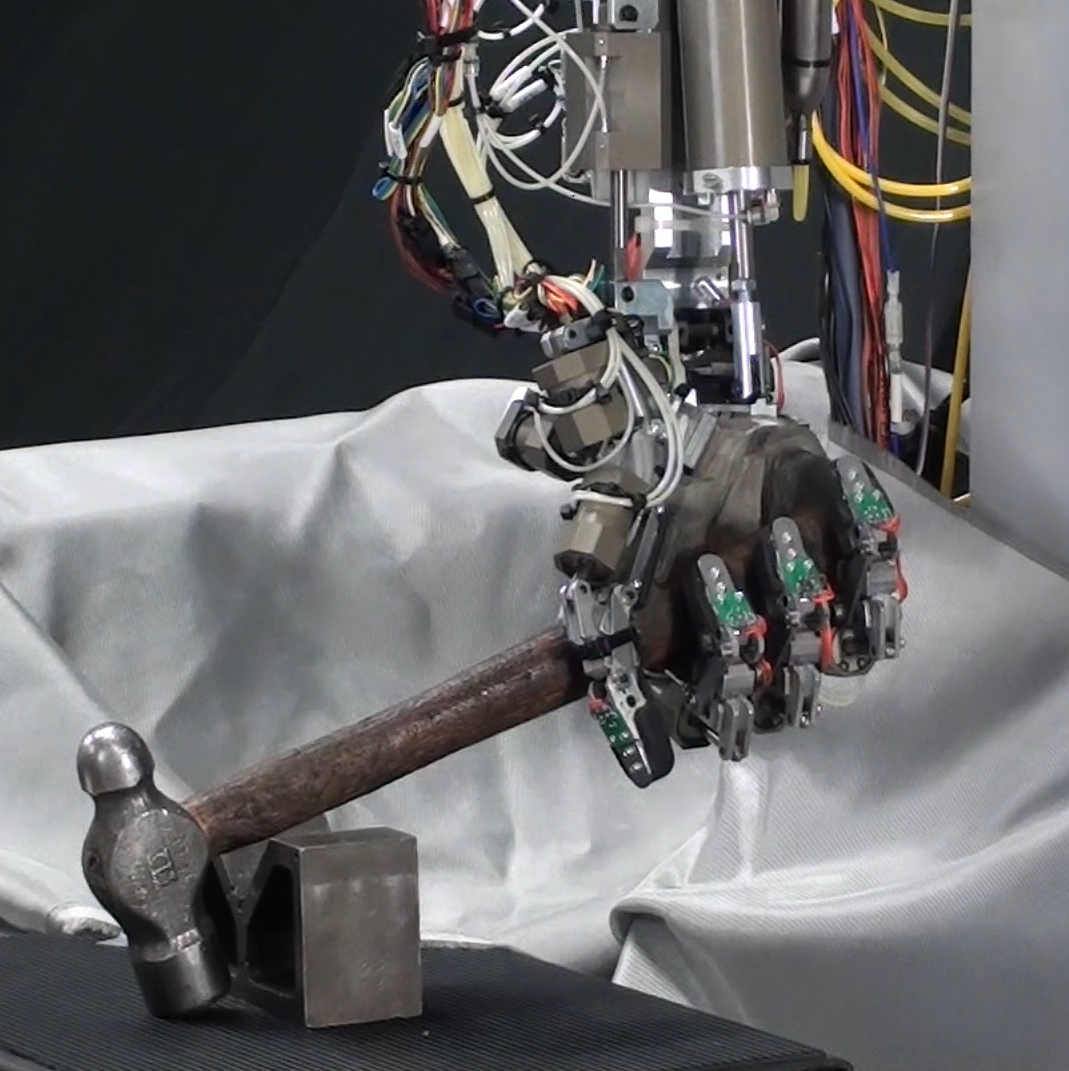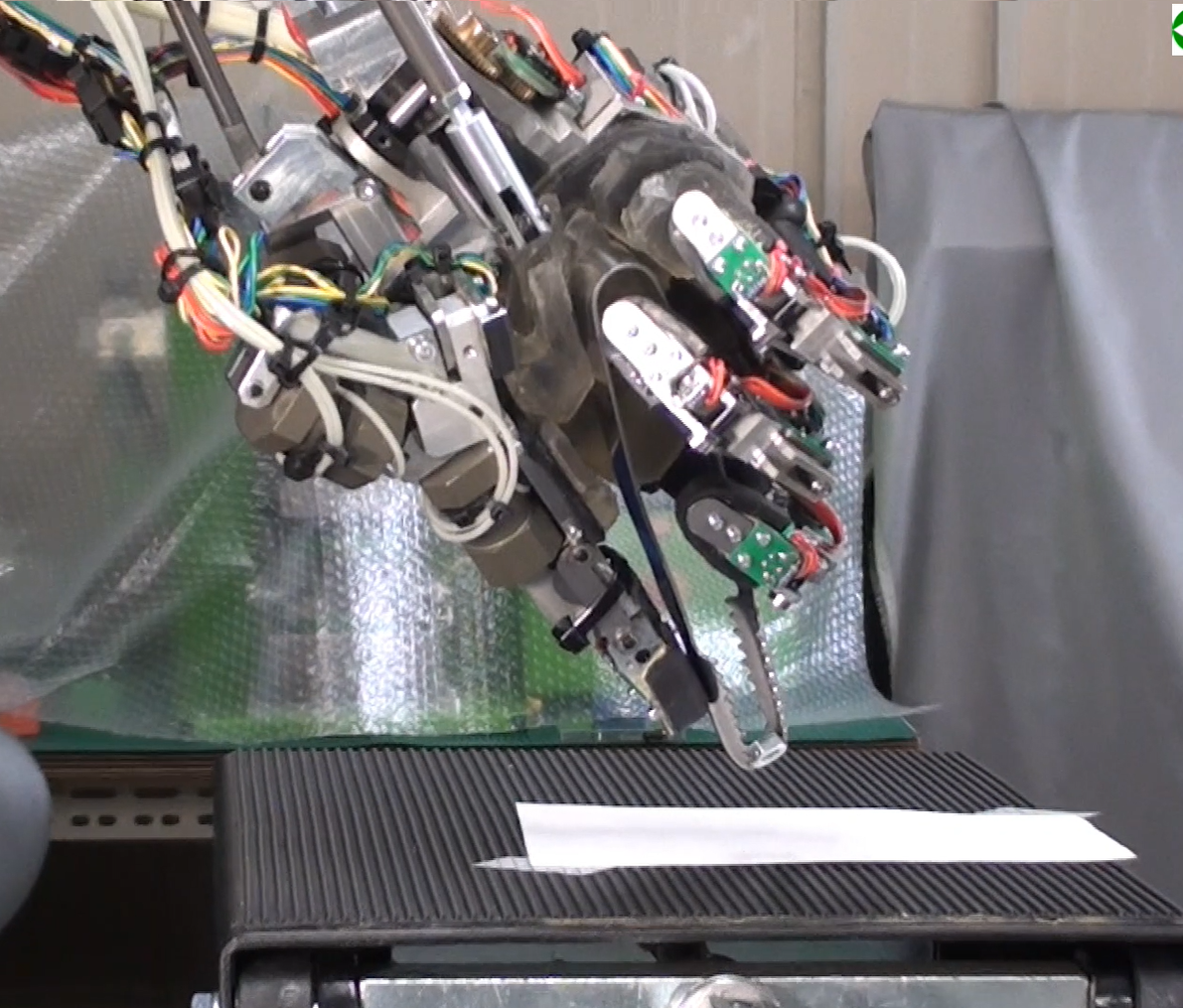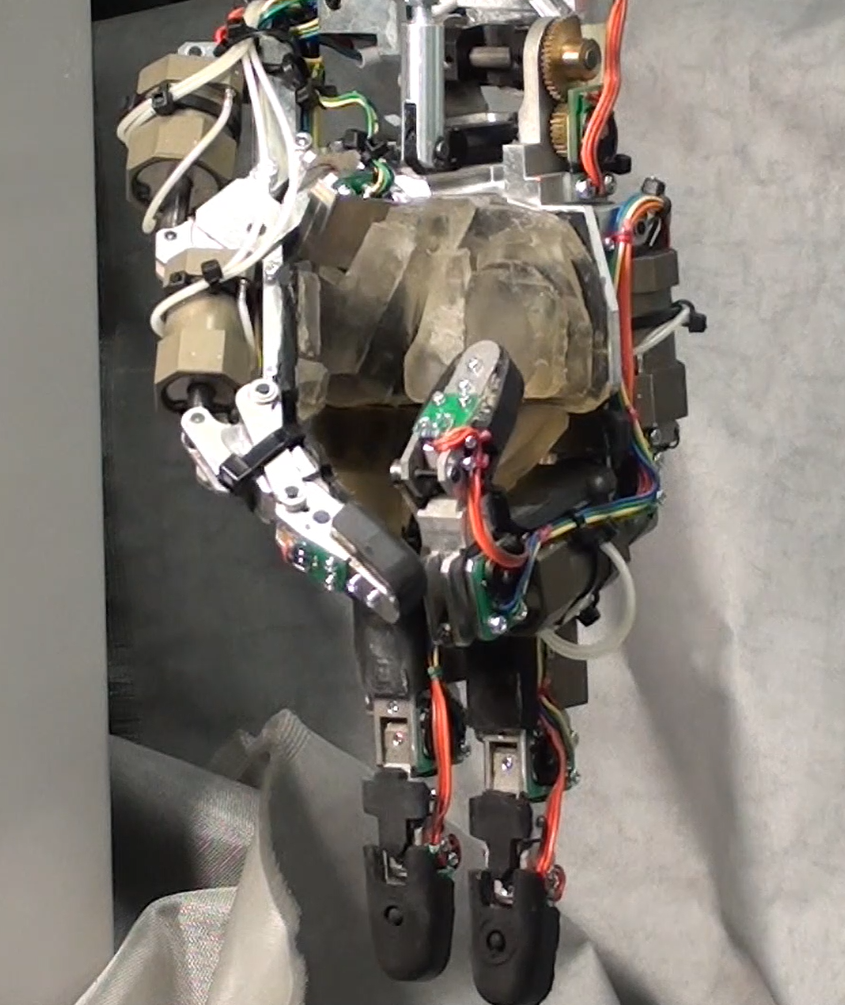
Development of humanoid robot with pneumatic control technology.
Application of ultra-compact pneumatic digital servo valve / patent registered
Development of humanoid disaster robot 2021.03.02 update
Approximately 30 years have passed since we continued to develop pneumatic control technology that can be applied to humanoid disaster robots, and we have finally reached the point where we can prove its realization.
Why Humanoid: Bipedalism allows you to move forward and backward over narrow or rugged areas, stairs and complex terrain. And the work of human arms and hands far exceeds the capabilities of ordinary mechanical devices. Since unexpected things always occur at the scene of a disaster, mechanical devices that can handle all situations are required, that is, humanoid robots. Moreover, it must be the same space and size as humans.
More importantly, humanoid robots are required to have the same level of arm strength, grip strength, and finger strength as humans.
This makes robot design very difficult. This is because even after spending more than 50 years, a practical humanoid disaster robot has not yet been realized. This homepage mentions the essential cause and proposes the new method.
Why Pneumatic: Currently, electrical servo technology is the mainstream of robot development. Hydraulic servo technology is also an established technology and is applied to humanoid robots. Various electric and hydraulic systems have been developed for the legs and arms, but I think it is very difficult to realize a hand in a limited space.
About 30 years ago, I realized that the only possibility was air pressure control, and started working on the development of servo technology that can be easily controlled using air pressure.
Development of Pneumatic Digital Servo Valve: And about 10 years ago, we developed the prototype of the ultra-small pneumatic digital servo valve. It is currently registered as a patent and is being applied for in several overseas countries. This servo valve can be driven only by the pulse output of the sequencer without the need for a dedicated driver circuit or amplifier circuit.
Due to the ultra-miniaturization, it has become possible to embed 18 pneumatic servo valves in the right arm shown in the video. When the whole body is made, all servo valves can be embedded in the body.
I am confident that this technology will continue to evolve.
Toward the development of humanoid disaster robots: There are many issues to be solved. While overcoming the weaknesses of pneumatic drive, we aim to realize a practical disaster robot. In the process, we believe that the range of applications for pneumatic digital servo valves will expand further.
Best regards.
Chikanari Kubo
Representative Director and President
Eishin Technology Co, Ltd.


Characteristics of Three Main Control Systems
① Electric Servomotor Control
〇 Advantages: At present, the electric servomotor control is more advanced than any other control technologies and makes it possible to easily control a number of machines and parts.
● Disadvantages: The power generated per unit volume of an actuator is low, and a speed reducer is needed. Conversion to straight line motion is difficult. As a result of position equilibrium control, a speed reducer is likely to be damaged by overload when the moment of inertia or exterior force is applied, and so a torque control is needed. It is necessary to increase the power supply capacity. Since the motor consists of copper wires and iron parts, the use of a plurality of motors makes the whole system heavy and cumbersome.
② Oil Hydraulic Control
〇 Advantages: The power output generated per unit volume of an actuator is very high and enables easy control. The oil hydraulic system is very sturdy.
● Disadvantages: Since an oil pressure generating source driven by a motor needs to be mounted, this system requires sufficient space and a strong power source or engine for the motor. An oil recovery route is also required.
③ Pneumatic Control
〇 Advantages: The power generated per unit volume of an actuator can be increased. As a result of power equilibrium control, the pneumatic control system is unlikely to be damaged by overload when the moment of inertia or exterior force is applied, and so the system can be flexibly used. No route for recovering consumed air is required. The system can be miniaturized, and the air and power supply source is minimized.
● Disadvantages: The controlling is extremely difficult, and therefore very few engineers think that it is possible to apply the pneumatic control method to robots.
Using current servomotor technology or hydraulic technology, it is a very difficult task to design an articulated robot that can perform almost human-like work and has power. The abilities of the arms and legs of various robots that are currently open to the public seem to have reached a fairly high level, but unfortunately we are facing great difficulties when it comes to hands.
However, the hand is the most important, and if we can make a hand with abilities close to humans, humanoid robots will make great progress.
We believe that the ultra-compact, pneumatic digital servo valve developed by our company has opened a breakthrough toward the realization of a humanoid disaster robot. To demonstrate this, I'll publish some videos.
Pay particular attention to the work of the robot's hands. Nine air cylinders, nine position sensors, and four sensory sensors are embedded in the hand, and ten servo valves for driving the fingers are mounted on the arm.
◆ Features of our developed pneumatic digital servo valve (patent registration)
1. It can be driven directly by the sequencer output.
2. It allows forward / backward, positioning and speed control of pneumatic CYL.
3. Ultra-small shape.

006 5Kg dumbbell 2021.03.02
This robot's hand has the grip strength and finger power of a human being, and the degree of freedom is quite close to that of a human being. See also other videos 006-014.
007 hammer 2021.03.02
The early commercialization of disaster robots is a requirement of the times, and therefore many researchers have made great efforts. However, there is a big reason why it has not been put to practical use yet. This is because it is not possible to design a device called a hand and a finger, which has power and functions close to humans, to fit in a space close to humans. Disaster robots are required to have the ability to do all kinds of work. Therefore, the work of hands and fingers is an extremely important factor.
If it becomes possible to manufacture a device that replaces human hands and fingers, that is, the hands of robots that are close to humans, there is no doubt that robots will become an important partner in human society.
008 Spanner 2021.03.02
With conventional technology, it is not possible to embed many joints with human-like power in this narrow space. We have developed a new control technology that uses air pressure to drive joints. The videos from 006 to 014 are to demonstrate this. Pay particular attention to how the robot's hands and fingers move.
009 Egg 2021.03.02
The grip strength and finger strength of the robot shown in the video are very large, but the reason why the robot can grasp even a fragile object such as an egg is that the pressure of the air moves the finger. The sensory sensor is embedded in the fingertips, but the action does not mean that the robot is grabbing the egg.
I think it is possible to grab an egg by devising even if you use an electric servo or a hydraulic servo. As mentioned above, air control is basically a force-balanced position control, so it can be said that it is easier than electric or hydraulic drive.
I think that more delicate performance will be possible if the force of the robot's fingers is controlled based on the information from the sensory sensor. This time, I didn't use the sensory sensor to control it because the sensor is located in a specific area of the finger.
010 12φ round bar 2021.03.02
It is quite difficult for a robot to hold a thin stick. Although not listed here, this hand can grab a round bar of about 6 mm to 10 cm.
011 Salad tongs + M6 nut 2021.03.02
Because the robot's fingers could not directly grasp the M6 nut, the robot's hand had tongs. The closer the robot's finger is to the human finger, the better the robot will be able to use the tools. By using the technology developed by our company, I think we can further evolve the way hands and fingers move.
012 Doorknob 2021.03.02
◆ Grasp the doorknob, turn it, return it, and remove it.
This performance is a prerequisite because disaster robots must enter and exit the building. However, what I found surprisingly difficult was that the knobs were very slippery. For this reason, I think that fingers need to have the proper surface material, roughness, and softness to cling to.
013 Finger power (first joint) 2021.03.02.
It is important for finger flexibility to be able to move the first and second joints independently. The third joint moves in conjunction with the second joint.
Not only the flexibility of the fingers but also the strength of the fingers is extremely important. This is a performance to prove the finger force that is the source of grip strength, and since this is an experiment when the air pressure is 0.6 MPa, the finger force will increase further as the pressure increases. If the robot bends the second joint 90 degrees and catches the weight, that joint can also hang a weight of 10 kg.
014 Dumbbell 26Kg 2021.03.02
◆ As the proof of grip strength, the hand is holding and lifting a dumbbell of 26 kg.
The 013 video proved that one finger has the ability to lift 10 kg. Actually, the first joint is set at an inclination of about 45 degrees, so it is estimated that the grip strength is 30 to 40 kg. I couldn't prepare any more weights, so I would like to prove it again.
Since the flow rate supplied to the pneumatic cylinder is kept low, the lifting speed is quite slow, but it is possible to make it faster.
If you try to lift your arm horizontally with a 5.0kg weight, a great force is generated around the shoulder muscles, and the stomach and back muscles are strained to keep balance. Furthermore, the human shoulder rotation range is large. This experimental equipment has been devised in order not only to simulate the foregoing factors but also to confirm the performance of pneumatic control of the stretched arm movement. We have conducted experiments for speed control, positioning control, and measures to counter the moment of inertia, using this equipment.
This video was filmed about four years ago. We have resumed the robot arm development after a three-year break and uploaded the video.
The robotic arm joint excluding the hand has been completed. This video shows the arm movement range at no load when there is no weight in the hand and the motion performance of the arm moved with each joint connected. It was confirmed as a result of this experiment that the 180°twisting motion performance is not sufficient, and we are planning to improve the performance.
● The motion of the arm with a 2.5kg weight is shown.
● Follow-up control is one of the techniques required to remote-control robots.
● The bending motion of the arm with a 7.5 or 12.5 weight is being displayed.
◆ Development Steps of Disaster Robots
1. Development of Right Hand
● The videos relating to this development step will be uploaded within one year.
● We aim to design the robotic right hand capable of handling a wrench or screwdriver with the human grasping power. The powerful finger joints are required for turning a doorknob to open and close the door, and removing obstacles to rescue people trapped in a disaster or accident.
● It would not be so difficult to place a sensor in each fingertip to enable the hand to hold a rounded object like an egg.
● As shown in the video, it would be most difficult to design the right arm and hand, because it is necessary to embed about 16 actuators and driving solenoids in one arm. However, overcoming this difficulty would make it easier to design the biped walking mechanism.
2. Development of Both Arms and Hands
● If the right arm and hand are completed, it would be easy to design the other arm and hand.
● At this development step, it will be most important to develop software for enabling both arms and hands to work together. The robots capable of handling a tool with the right hand while holding something with the left could have limitless possibilities.
3. Development of Biped Walking Model
● Biped walking is not a prerequisite for disaster robots. They can be equipped with three, four or more legs. Considering mobility in a small space, however, the biped walking model is thought to be the most desirable.
● The robot must have flexible hip, groin and ankle joints and several fingers similar to human ones in order to stand up on its own after falling down in the rubble during restoration or rescue operations. These body parts need to be powerful enough. At this step, therefore, it will be important to develop software for enabling both legs and hands to work together so that the robot can stand up.
● Furthermore, the robot must be able not merely to support its weight but also to withstand the load that is double the weight of its own in order to work in a disaster. The volume of the legs is large compared to the arms, but control by a large diameter cylinder enables powerful robotic legs.
● The equilibrium sensor is also an indispensable element to the biped walking mechanism. Therefore, it will be necessary to develop software for comprehensively judging the position and inclination of the head, chest, stomach and hip, and the gravity center of the body.
4. Development of Remote Control Technology
● A Robot working in a disaster needs to be controlled from a great distance. For this purpose, high-level communications technology is required for bidirectional transmission of information including the distance, direction and color as well as what the robot senses with the eyes and ears.
● The manipulator suit, in which the sensors required for robot manipulation can be embedded, needs to be developed, for example, in order for the manipulator to accurately feel what the robot feels with the fingertips or for the robot to exert force at the same time the manipulator applies force to the fingertips. The manipulator can determine the degree of force to be applied and the work site conditions by feeling exactly as the remote-controlled robot does through bidirectional transmission, thereby making the robot perform detailed tasks.
● The robot can work with a thin air hose and power supply cables connected , but it would be desirable to develop the gas cylinder and the battery to allow the robot to work more freely. For pneumatic robots, liquid nitrogen and ordinary cylinders could be used as the driving pressure source.
● The relay stations for air and power supply need to be established, too. Furthermore, the system for enabling the robot itself to fill up the empty cylinder and recharge the battery.
5. System Development for Robots Capable of Withstanding all Kinds of Disasters
● Humans can’t perform rescue or restoration operations in a harsh environment such as a fire, a water environment and an area contaminated with poisonous gas or radioactive materials. I will be necessary to design parts and systems capable of withstanding harsh disaster conditions.
● We are currently developing robots based only on engineering aspects, but in the last development step, it will be important to consider disaster environments from every perspective to prevent robots from being damaged.
◆Application of Pneumatic Control to Other Types of Robots
1. Application to Development of Nursing Care Robots and Industrial Robots
● We are definitely interested in these types of robots, and if sufficient funds and human resources can be procured, we would like to embark on a related project.
2. Development of Robots other than Humanoids
● We are planning to develop four-legged robots, multiple-legged lizard or snake type robots and other types of dream robots.
3. Sale of Parts to Hobbyists and Researchers
● We are going to consider selling robot kits to enthusiastic hobbyists and supplying parts to researchers in the future in order to promote pneumatic robot development activities and at the same time procure development funds.
